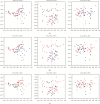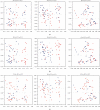Betaine Modulates Rumen Archaeal Community and Functioning during Heat and Osmotic Stress Conditions In Vitro
- PMID: 33144849
- PMCID: PMC7599403
- DOI: 10.1155/2020/8875773
Betaine Modulates Rumen Archaeal Community and Functioning during Heat and Osmotic Stress Conditions In Vitro
Abstract
Rumen archaea play an important role in scavenging ruminal hydrogen (H2) and thus facilitate rumen fermentation. They require optimum temperature and osmolality for their growth and metabolism; however, a number of external factors may put archaea under heat and osmotic stress. Betaine is an osmolyte, molecular chaperone, and antioxidant; therefore, it bears potential to combat against these stressors. In this in vitro study, three betaine levels, namely, 0 (control), 51 (low), and 286 (high) ppm, were used. Each of these was subjected to two temperatures (39.5 and 42°C) and two osmolality conditions (295 and 420 mOsmol kg-1) with n = 6 per treatment. Sequencing analyses of the solid phase (which use solid materials containing primarily fibrous materials of low-density feed particles) and the liquid phase (rumen fermenter liquid) using 16S rRNA revealed that more than 99.8% of the ruminal archaea in fermenters belong to the phylum Euryarchaeota. At the genus level, Methanobrevibacter was the most prevalent in both phases, and Methanosaeta was only detected in the liquid phase. The genera Methanobrevibacter and Methanobacterium both showed a positive correlation with methane (CH4) formation in the liquid and solid phases, respectively (P < 0.05). Heat stress increased the relative abundance of genus Methanimicrococcus at the expense of candidate archaeal genus Vadin CA11 (P < 0.05). In the solid phase, osmotic stress significantly reduced the Shannon and Simpson indices of diversity, and relative abundance was higher for Methanobrevibacter at the expense of Methanimicrococcus. In the liquid phase, osmotic stress increased not only the abundance-based coverage estimator (ACE) and singles parameters of diversity but also the relative abundances of Methanosphaera and Methanobacterium. The overall decrease in all gas parameters and estimated metabolic hydrogen ([2H]) utilization was observed during osmotic stress conditions (P < 0.05). Betaine enhanced the diversity of solid phase archaea as indicated by the increase in ACE and singles during heat stress, and only a high dose improved all diversity parameters in the liquid phase during osmotic stress (P < 0.05). Thus, betaine alleviates the effects of heat stress and osmotic stress on the archaea community.
Copyright © 2020 Mubarik Mahmood et al.
Conflict of interest statement
The authors declare that there is no conflict of interest.
Figures




Similar articles
-
Betaine addition as a potent ruminal fermentation modulator under hyperthermal and hyperosmotic conditions in vitro.J Sci Food Agric. 2020 Mar 30;100(5):2261-2271. doi: 10.1002/jsfa.10255. Epub 2020 Jan 28. J Sci Food Agric. 2020. PMID: 31917480 Free PMC article.
-
Nitrate decreases ruminal methane production with slight changes to ruminal methanogen composition of nitrate-adapted steers.BMC Microbiol. 2018 Mar 20;18(1):21. doi: 10.1186/s12866-018-1164-1. BMC Microbiol. 2018. PMID: 29554875 Free PMC article.
-
Few highly abundant operational taxonomic units dominate within rumen methanogenic archaeal species in New Zealand sheep and cattle.Appl Environ Microbiol. 2015 Feb;81(3):986-95. doi: 10.1128/AEM.03018-14. Epub 2014 Nov 21. Appl Environ Microbiol. 2015. PMID: 25416771 Free PMC article.
-
Composition of bacterial and archaeal communities in the rumen of dromedary camel using cDNA-amplicon sequencing.Int Microbiol. 2020 May;23(2):137-148. doi: 10.1007/s10123-019-00093-1. Epub 2019 Aug 20. Int Microbiol. 2020. PMID: 31432356 Review.
-
Genome sequencing of rumen bacteria and archaea and its application to methane mitigation strategies.Animal. 2013 Jun;7 Suppl 2:235-43. doi: 10.1017/S1751731113000700. Animal. 2013. PMID: 23739466 Review.
Cited by
-
Comparison of enteric methane yield and diversity of ruminal methanogens in cattle and buffaloes fed on the same diet.PLoS One. 2021 Aug 11;16(8):e0256048. doi: 10.1371/journal.pone.0256048. eCollection 2021. PLoS One. 2021. PMID: 34379691 Free PMC article.
-
Winery by-products as a feed source with functional properties: dose-response effect of grape pomace, grape seed meal, and grape seed extract on rumen microbial community and their fermentation activity in RUSITEC.J Anim Sci Biotechnol. 2023 Jul 10;14(1):92. doi: 10.1186/s40104-023-00892-7. J Anim Sci Biotechnol. 2023. PMID: 37424021 Free PMC article.
-
Betaine Dietary Supplementation: Healthy Aspects in Human and Animal Nutrition.Antioxidants (Basel). 2025 Jun 23;14(7):771. doi: 10.3390/antiox14070771. Antioxidants (Basel). 2025. PMID: 40722875 Free PMC article. Review.
-
Rumen-mammary gland axis and bacterial extracellular vesicles: Exploring a new perspective on heat stress in dairy cows.Anim Nutr. 2024 Sep 16;19:70-75. doi: 10.1016/j.aninu.2024.08.003. eCollection 2024 Dec. Anim Nutr. 2024. PMID: 39628643 Free PMC article. Review.
References
Publication types
MeSH terms
Substances
LinkOut - more resources
Full Text Sources
Miscellaneous

